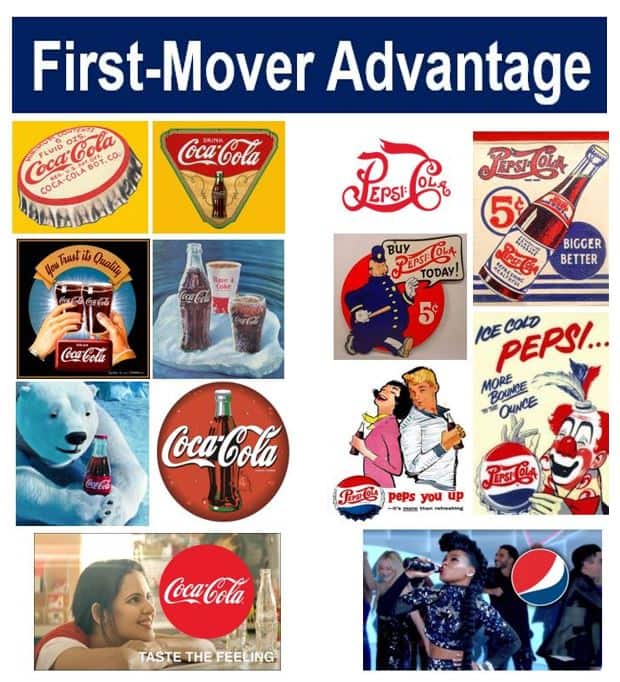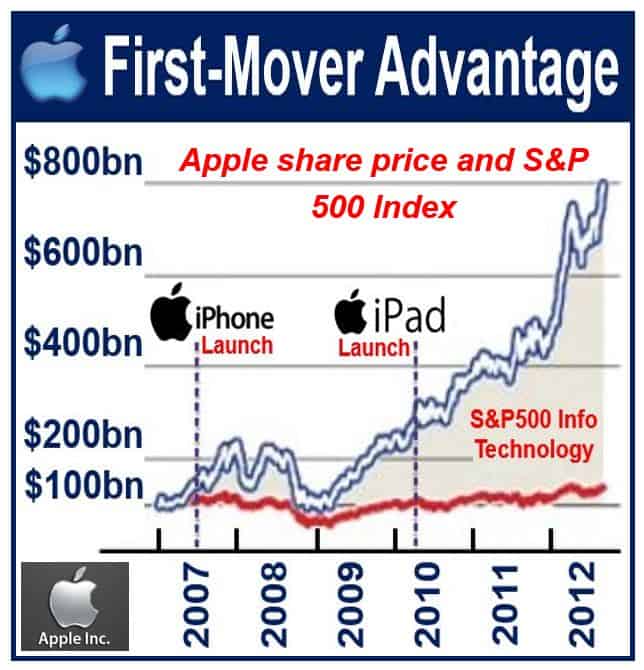First Mover Advantage or FMA is a notion from game theory that the first to enter a market can obtain a massive advantage such as brand name recognition, customer loyalty, market share, etc.
By setting industry standards and consumer expectations, first movers can shape market trends and define the competitive landscape for years to come.
The same applies for the first to introduce an innovation. The advantage is not just because the first company can erect barriers to entry, but also because competitors and rivals may be put off from committing the required resources to compete.
First movers who innovate create new customer needs and demand, effectively cultivating entirely new markets for their products and services.
The term today is often referred to as technological leadership.
The main first-mover advantage is control of resources. With this edge over its competitors, the first-mover can be rewarded with considerable profit margins and a status of virtual monopoly.
Not all companies that enter a market first enjoy first-mover advantage – first-mover disadvantage also exits. If the first-mover does not capitalize on its advantage, other new entrants will have the opportunity to come in and compete more effectively and efficiently – they will have second-mover advantage.
Applies to just ‘significant’ first-movers
First-mover advantage only refers to a significant company that moves into a market, not just any company. For example, even though Amazon.com was not the first entity to sell books on the Internet, it was the first significant company to do so (many people think Amazon was the first – it wasn’t!).
In today’s Internet economy, first-mover advantage is instrumental in building market share. However, online marketers say this does not always mean that the first-mover makes a profit.
Being a first-mover is only worth it if the risks are outweighed by the rewards.
In some markets, the first-mover is rewarded with quasi-monopoly status and gigantic profits. In other industries, however, such rewards do not exist, and late-movers can move in and still compete effectively against the earlier entrants.
The world of business in some ways is very similar to animal survival. When a cheetah hunts down a gazelle, it is the first-mover and has a fantastic opportunity to eat to its heart content. However, if there are hyenas nearby, i.e. second-movers, they can grab the cheetah’s catch and enjoy all the benefits. Although the first-mover did all the work, the second-movers got the profits.
First-mover advantage elements
First-mover advantage is typically not just one single advantage, but rather a cluster of advantages that the innovating company gets by being the first one in.
One of the main advantages is brand name recognition. In the history of business, companies like Coca-Cola, STP and Kellogg’s brand name recognition was one of the biggest rewards for being first-movers.
Apart from engendering loyalty among existing customers, brand name recognition also attracts new customers, even after second-movers and later-movers have entered the market.
Economies of scale represent an advantage that is only really there for the first-mover. This is especially the case for manufacturers and makers of technology-based products.
The first-mover has a longer learning curve, during which it establishes more cost-efficient means of making a product and delivering it.
Another first-mover advantage is switching costs. As soon as the first mover sells something to a customer, he or she may be discouraged from switching to a rival product because of the cost. If a company purchases a Windows system for all its computers, it is unlikely to switch to another system rapidly.
The first-mover has a unique opportunity to build up relationships with suppliers, use a wider range of available website names, and recruit key workers.

First-mover pros and cons
As is the case in all business ventures where the potential for big profits exists, there are also significant risks.
The advantages
– The first mover can develop a huge competitive advantage through learning by doing – making it prohibitively difficult and expensive for other rivals to enter.
– First-movers can exploit internal economies of scale, build brand loyalty, and focus on repeat demand.
– Consumer behavior can be molded early on so that it becomes habitual. This places the company in a unique position.
The disadvantages
– Some of the first-mover’s employees may leave the company and compete against it with new challenge brands. There is a risk that the leavers take some of the intellectual capital with them.
– The failure rate for first-movers is high, i.e. it is a venture fraught with danger.
– Second-movers watch and learn, and are less likely to make the same mistakes that the first-mover made.
 By being the first-mover in the smartphone and tablet markets, Apple Inc. saw its share price and S&P 500 Index rise.
By being the first-mover in the smartphone and tablet markets, Apple Inc. saw its share price and S&P 500 Index rise.
First-mover advantage examples
Some massive companies that sell products all over the world would not be where they are today had they not been first-movers.
Perhaps the best example of an ultra-successful first mover is the Coca-Cola Company (Coke). Coke was invented by John S. Pemberton in 1896.
When Caleb Bradham launched Pepsi-Cola thirteen years later, customers were already purchasing over one million gallons of Coke each year.
Over the past century, Pepsi has been trying to play catch-up with Coke, but Coca-Cola, the first-mover, has always had that edge. In 2014, the Coca-Cola brand was valued at $79 billion.
Other examples of successful first movers are e-commerce giant eBay, and Kleenex, the brand name for a variety of paper-based products such as facial tissue, which today belongs to Kimberly-Clark.
Second-mover advantage example
Amazon.com is a good example of a second-mover advantage company. Jeff Bezos founded Amazon.com in 1994 as an online bookstore – it was launched one year later. Product lines were rapidly expanded to include CDs, computer software, video games, toys, furniture, VHS, DVD, and some other items.
What many people don’t know is that Books.com (Books Stacks Unlimited) was launched in 1992. It was the very first online bookstore.
Amazon.com is today an S&P 100 company and the largest online retailer in the United States. Book Stacks Unlimited was sold to Barnes and Noble.
Harnessing first-mover advantage in various industries
The concept of “First-Mover Advantage” is pivotal across a spectrum of industries, from technology to retail. Here are some sentences that show you how we use the term in a variety of sentences:
- “Tech startups often chase first-mover advantage to dominate the market before competitors even enter the race.”
- “With its first-mover advantage, the company was able to patent its innovations, thereby setting high barriers for future competitors.”
- “The brand’s first-mover advantage allowed it to secure the most favorable retail locations, giving it high visibility among consumers.”
- “Due to first-mover advantage, the pharmaceutical company was able to form strong partnerships with distributors, crucial for its widespread market penetration.”
- “In the rapidly evolving app market, first-mover advantage can be fleeting, with copycat products quickly emerging.”
- “The streaming service’s first-mover advantage was crucial in securing a large subscriber base before other major players could offer competing services.”
- “Despite having a first-mover advantage, the company learned it also needed to continuously innovate to maintain its market position against agile new entrants.”
Video explanation
